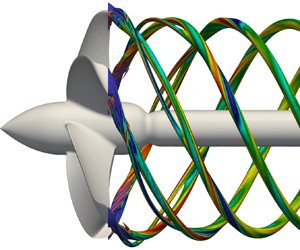Crossref Citations
This article has been cited by the following publications. This list is generated based on data provided by
Crossref.
Posa, A.
and
Broglia, R.
2022.
Influence by the hub vortex on the instability of the tip vortices shed by propellers with and without winglets.
Physics of Fluids,
Vol. 34,
Issue. 11,
Wang, Lianzhou
Liu, Xinyu
Guo, Jianwei
Li, Mijian
and
Liao, Jianbin
2023.
The dynamic characteristics in the wake systems of a propeller operating under different loading conditions.
Ocean Engineering,
Vol. 286,
Issue. ,
p.
115518.
Posa, A.
and
Broglia, R.
2023.
Influence of the load conditions on the acoustic signature of a tip-loaded propeller with winglets.
Physics of Fluids,
Vol. 35,
Issue. 4,
Walvekar, Omkar
and
Chakravarthy, Satyanarayanan
2023.
An Unsteady Reynolds–Averaged Navier–Stokes–Large Eddy Simulation Study of Propeller–Airframe Interaction in Distributed Electric Propulsion.
Aerospace,
Vol. 11,
Issue. 1,
p.
17.
Chen, Chen-Wei
Chen, Xu-Peng
Zhou, Zhao-Ye
Chen, Li-Wan
Zhang, Chi
Zheng, Tian-Jiang
and
Li, Hua-Min
2023.
Effect of Tip Rake Distribution on the Hydrodynamic Performance of Non-Planar Kappel Propeller.
Journal of Marine Science and Engineering,
Vol. 11,
Issue. 4,
p.
748.
Gaggero, Stefano
2023.
A Study on the Wake Evolution of a Set of RIM-Driven Thrusters.
Journal of Marine Science and Engineering,
Vol. 11,
Issue. 9,
p.
1659.
Posa, A.
Felli, M.
and
Broglia, R.
2023.
Acoustic far field of a propeller working in the wake of a hydrofoil.
Physics of Fluids,
Vol. 35,
Issue. 12,
Gaggero, Stefano
and
Ferrando, Marco
2023.
Wake Instabilities of Tip-Loaded Propellers: Comparison between CLT and “New Generation” CLT Configurations.
Journal of Marine Science and Engineering,
Vol. 11,
Issue. 1,
p.
112.
Posa, A.
Broglia, R.
Balaras, E.
and
Felli, M.
2023.
The acoustic signature of a propeller–hydrofoil system in the far field.
Physics of Fluids,
Vol. 35,
Issue. 7,
Posa, Antonio
2023.
Anisotropy of turbulence at the core of the tip and hub vortices shed by a marine propeller.
Journal of Fluid Mechanics,
Vol. 969,
Issue. ,
Wang, Lianzhou
Liu, Xinyu
Chao, Xinyue
Guo, Jianwei
and
Liao, Jianbin
2023.
Modeling of wake features of a propeller using the vorticity confinement method.
Physics of Fluids,
Vol. 35,
Issue. 7,
Posa, A.
2023.
Comparison between the acoustic signatures of a conventional propeller and a tip-loaded propeller with winglets.
Physics of Fluids,
Vol. 35,
Issue. 2,
Posa, Antonio
Viola, Ignazio Maria
and
Broglia, Riccardo
2024.
Influence of the tip speed ratio on the wake dynamics and recovery of axial-flow turbines.
Physics of Fluids,
Vol. 36,
Issue. 5,
Portillo-Juan, Adrian
Saettone, Simone
Andersen, Poul
and
Ferrer, Esteban
2024.
Hydro-acoustic optimization of propellers: A review of design methods.
Applied Ocean Research,
Vol. 151,
Issue. ,
p.
104158.
Lu, Jiaxin
Lu, Yang
Wang, Junjie
Xu, Xice
Shao, Mengxue
and
Tang, Zhengfei
2024.
Numerical study on the hydrodynamic performance and wake dynamics of propulsive wing propulsors with different cross-flow fans.
Physics of Fluids,
Vol. 36,
Issue. 1,
Ryu, Seo-Yoon
Cheong, Cheolung
Kim, Jong Wook
and
Park, Byung Il
2024.
Analysis of aerodynamic and aeroacoustic performances of axial flow fans with variable winglet curvature in chordwise direction.
Results in Engineering,
Vol. 21,
Issue. ,
p.
101857.
Posa, A.
Capone, A.
Alves Pereira, F.
Di Felice, F.
and
Broglia, R.
2024.
Interaction between the helical vortices shed by contra-rotating propellers.
Physics of Fluids,
Vol. 36,
Issue. 5,
Posa, Antonio
Broglia, Riccardo
Shi, Weichao
and
Felli, Mario
2024.
Large eddy simulation of a marine propeller with leading edge tubercles.
Physics of Fluids,
Vol. 36,
Issue. 11,
Wang, Lianzhou
Huang, Hao
Huang, Chenyu
and
Liu, Xinyu
2025.
Investigation on the vortex dynamics in the wake of a rotating propeller.
International Journal of Mechanical Sciences,
Vol. 287,
Issue. ,
p.
109918.
He, Kangjian
Zhao, Weiwen
and
Wan, Decheng
2025.
Physical characteristics of wall pressure fluctuations for fully developed turbulent annular channel flows.
Physics of Fluids,
Vol. 37,
Issue. 4,




